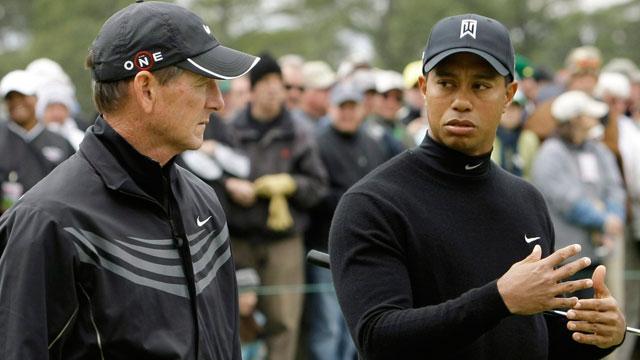Hank Haney’s book about working with Tiger Woods hits stores March 27. Golf World obtained a copy and explored some of its more interesting details
By now, you’ve likely heard some of the early revelations in The Big Miss, Hank Haney’s book about his stint as Tiger Woods’ swing coach; that Woods was obsessed with the military and dreamed of becoming a Navy SEAL; that he hurt his knee not while running (as he claimed) but while participating in Navy SEAL-type training exercises; and even that he didn’t share his popsicles with Haney.
Golf World obtained a copy of The Big Miss last week and gave it to golfdigestcanada.ca to read.
Here are seven more things the book teaches us about Woods:
Tiger’s daredevil streak extended elsewhere
Considering his SEAL experiences, it stands to reason that Tiger was not averse to taking risks. Woods had a well-known affinity for ocean diving, and Haney recalls the first time Woods went skiing in Park City, Utah, with his wife, Elin, Mark O’Meara and his wife and Haney and his wife. Woods began on a beginner’s slope then decided he would attempt something more challenging. A friend of O’Meara’s, an expert skier, advised Woods to turn often in order to control his speed.
"Don’t worry, I’ll be fine," Tiger replied, at which point he took off straight down the hill, eschewed turns and quickly gained speed.
Weight training became an obsession for Woods
Woods’ workout regimen veered far from golf specific and was likely detrimental to his game. It also led to odd injuries:
• Woods hurt his right Achilles tendon doing Olympic-style lifts, friend Corey Carroll told Haney. Woods claimed the injury came from running while testing new shoes for Nike. "Getting the right Achilles treated was the reason Dr. Anthony Galea was called in," Haney writes, alluding to the blood-spinning therapy that Galea administered to Woods at his home.
• Haney witnessed Woods limping after running 60-yard sprints while wearing a weighted vest, an idea he got from a friend, Vencie Glenn, a former NFL safety.
Tiger’s closest confidant? Mark Steinberg
Former basketball stars Michael Jordan and Charles Barkley were thought to be close buddies with Tiger, but Haney said he didn’t see them much with the golfer. Barkley, with whom Haney worked on the Golf Channel show "The Haney Project," wanted to become closer to Woods, but "he was baffled by Tiger being closed off and keeping him at a distance."
Haney writes that the point man for Team Tiger, agent Mark Steinberg, was his "closest confidant" and that Steinberg "considered Tiger a good person trapped in a very complicated and demanding life, and he cut Tiger a lot of slack when he was being uncommunicative or stubborn."
Tiger began to neglect his short game
Woods had built a reputation for being a sponge when it came to the golf swing, but Haney learned that wasn’t actually the case. "I realized right away that he was going to be a difficult student," and that "he was something of a chronic experimenter who could get off track without guidance."
Haney writes that one misconception of Tiger was that he was more familiar with the golf swing than his PGA Tour contemporaries, a realization he came to not long after they started working together.
Haney was also concerned that Woods wasn’t as dedicated to his short game after coming back from knee surgery after the U.S. Open in 2008. "There was still room for improvement, and he knew it," Haney writes. "I worried that not taking that on was a sign that his drive was beginning to wane in the same way it had in early 2007."
Tiger was selective with his friendships on tour:
Woods was more likely to befriend players who did not pose a competitive threat.
Writes Haney: "Those he genuinely liked tended to be quiet, modest, hardworking guys like Jim Furyk and Steve Stricker whose ability he respected but whose talent didn’t elevate them to the position of serious rival."
A player whom he was not particularly fond of was Ian Poulter, who after a practice round at Oakmont a few weeks before the 2007 U.S. Open "was cheeky enough to ask Tiger, ‘How are we getting home?’ " Both lived in the Orlando area, and Poulter knew that Woods had a private jet standing by. Though Woods never extended an invitation, Poulter showed up at the jetport anyway. "Can you believe how this d— mooched a ride on my plane?" Woods wrote in a text to Haney as the three of them were flying back to Orlando.
Woods wanted to keep working with Haney after they split
When Haney resigned as Woods’ instructor, Tiger insisted that they would still work together. "For some reason that I still can’t figure out, he just didn’t want to let go," writes Haney. " ‘Tiger,’ I said, ‘if you ever want me to watch you or help you with an opinion, as a friend I’ll be happy to do it. But we’re not going to work together. I’m never going to be your coach again.’ " When Woods reasserted, "We’re still going to work together," Haney replied, "No, we’re not."
After rehab, Elin wanted Tiger to quit golf for two years
After Woods returned from a month-long stint in a Mississippi clinic, "he described his therapy as ‘horrible, the worst experience I’ve ever been through,’ and ‘the hardest thing I’ve ever done,’ but he didn’t offer any details," Haney writes. When he asked about Elin, Woods said, "We’re trying," and that Elin "wants me to not play golf for two years."
In his final chapter, "Summing Up," Haney cites his wish list.
It included this: "I wish Tiger had come back from rehab a different person. Not a lot different, just a little warmer and more open … I realize now that as hard as I tried to understand Tiger, he tried just as hard not to let me."


